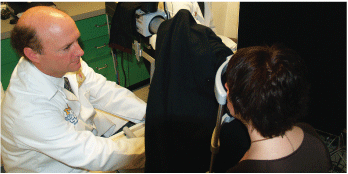A new, non-invasive retinal imaging device could provide early evidence of diabetes or diabetic eye disease, according to a study in the July Archives of Ophthalmology.

Richard Hackel, ophthalmic photographer, tests for signs of elevated metabolic stress, which may suggest that the patient has diabetes or diabetic eye disease.
Normally, patients with undetected diabetes must either undergo an oral glucose test or exhibit physical damage before a diagnosis can be made. However, this instrument identifies elevated levels of flavoprotein autofluorescence (FA) in retinal tissue, which is caused by increased metabolic stress, before diabetic tissue damage is evident.
The study measured the FA levels of 21 subjects with either type 1 or type 2 diabetes and compared the findings to 21 healthy, age-matched subjects. The researchers discovered that FA levels were significantly higher in subjects with diabetes or diabetic eye disease than in the healthy subjects. The researchers conclude that FA technology may enable clinicians to diagnose patients with diabetes earlier and initiate treatment before extensive ocular tissue damage occurs.
FA technology could be revolutionary for optometry, if it does indeed allow clinicians to intervene early to protect the eye from advancing diabetic changes, says Andrew S. Gurwood, O.D., of
Currently, the Diabetic Retinopathy Study and the Early Treatment Diabetic Retinopathy Study are the standard guidelines used for the treatment of proliferative diabetic retinopathy and clinically significant macular edema; however, in each case retinopathy must be present and visible in order for action (such as laser or anti-VEGF treatments) to be considered, Dr. Gurwood says.
But, if FA can be used to modify dietary habits and increase blood glucose control, along with HbA1c, perhaps the test will allow us to leap forward, inspect the patients future, and then modify the present to change the course of disease, he says.
Field MG, Elner VM, Puro DG, et al. Rapid, noninvasive detection of diabetes-induced retinal metabolic stress. Arch Ophthalmol 2008 Jul;126(7):934-8.

